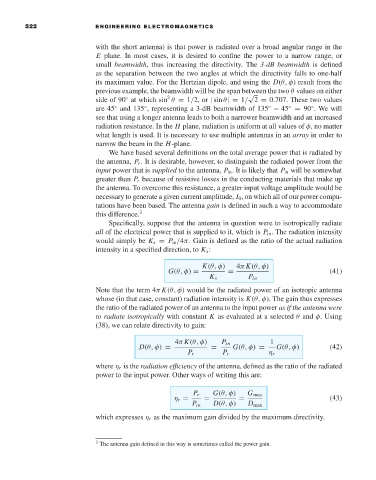Page 540 - Engineering Electromagnetics, 8th Edition
P. 540
522 ENGINEERING ELECTROMAGNETICS
with the short antenna) is that power is radiated over a broad angular range in the
E plane. In most cases, it is desired to confine the power to a narrow range, or
small beamwidth, thus increasing the directivity. The 3-dB beamwidth is defined
as the separation between the two angles at which the directivity falls to one-half
its maximum value. For the Hertzian dipole, and using the D(θ, φ) result from the
previous example, the beamwidth will be the span between the two θ values on either
√
2
side of 90 at which sin θ = 1/2, or | sin θ|= 1/ 2 = 0.707. These two values
◦
are 45 and 135 , representing a 3-dB beamwidth of 135 − 45 = 90 .We will
◦
◦
◦
◦
◦
see that using a longer antenna leads to both a narrower beamwidth and an increased
radiation resistance. In the H plane, radiation is uniform at all values of φ,no matter
what length is used. It is necessary to use multiple antennas in an array in order to
narrow the beam in the H-plane.
We have based several definitions on the total average power that is radiated by
the antenna, P r .Itis desirable, however, to distinguish the radiated power from the
input power that is supplied to the antenna, P in .Itis likely that P in will be somewhat
greater than P r because of resistive losses in the conducting materials that make up
the antenna. To overcome this resistance, a greater input voltage amplitude would be
necessary to generate a given current amplitude, I 0 ,on which all of our power compu-
tations have been based. The antenna gain is defined in such a way to accommodate
this difference. 3
Specifically, suppose that the antenna in question were to isotropically radiate
all of the electrical power that is supplied to it, which is P in . The radiation intensity
would simply be K s = P in /4π. Gain is defined as the ratio of the actual radiation
intensity in a specified direction, to K s :
K(θ, φ) 4π K(θ, φ)
G(θ, φ) = = (41)
K s P in
Note that the term 4π K(θ, φ)would be the radiated power of an isotropic antenna
whose (in that case, constant) radiation intensity is K(θ, φ). The gain thus expresses
the ratio of the radiated power of an antenna to the input power as if the antenna were
to radiate isotropically with constant K as evaluated at a selected θ and φ. Using
(38), we can relate directivity to gain:
4π K(θ, φ) P in 1
D(θ, φ) = = G(θ, φ) = G(θ, φ) (42)
P r P r η r
where η r is the radiation efficiency of the antenna, defined as the ratio of the radiated
power to the input power. Other ways of writing this are:
G(θ, φ)
P r G max
η r = = = (43)
P in D(θ, φ) D max
which expresses η r as the maximum gain divided by the maximum directivity.
3 The antenna gain defined in this way is sometimes called the power gain.

